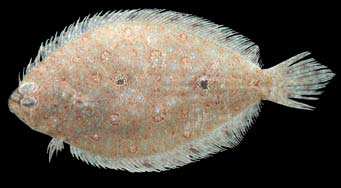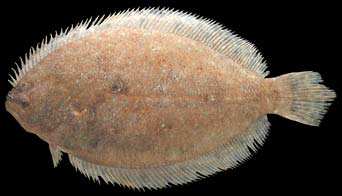PARALICHTHYIDAE
Sand Flounders
By Keiichi Matsuura and Seishi Kimura
 Pseudorhombus argus |
 Pseudorhombus arsius |
|
Body oval, strongly compressed, reaching to 40 cm. Head large, 3.0-4.4 in SL. Mouth large; upper jaw on the eyed side reaching posteriorly below eyes; teeth uniserial on both jaws. Eyes on left side of head, separated by a bony ridge. Dorsal fin originating before eyes. Pectoral fins not elongate, middle 6-9 rays branched on eyed side, but all rays unbranched on blind side. Pelvic fins lacking spines, short based, subequal and subsymmetrical in position, posterior 3 or 4 rays branched. Scales cycloid or ctenoid on both sides. Lateral line equally developed on both sides, with a distinctive curve above pectoral fins and a supratemporal branch, running to anterior part of dorsal fin. Color: body brownish or light greenish with dark spots or rings. Similar families occurring in the area. Bothidae: pelvic fin on eyed side on mid-ventral line, its origin anterior to that of blind side; pelvic fin of blind side above mid-ventral line; no lateral line below lower eye. Citharidae: eye on right or left side of head; pelvic fins with I spine and 5 soft rays. Cynoglossidae: dorsal and anal fins joined with caudal fin; pectoral fins absent in adults; rostral hook usually present below mouth. Psettodidae: eyes on right or left side of head; upper eye on dorsal edge of head; dorsal fin origin far behind eye. Remarks. Most species found on muddy and sandy bottoms of the continental shelf. Caught with bottom trawls and marketed mostly fresh, also dried-salted. |

|
|